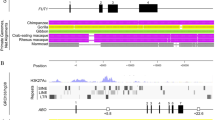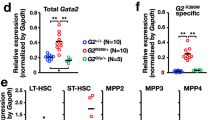Abstract
The complement regulatory protein CD59 inhibits formation of the membrane attack complex (MAC), the terminal effector of the complement system. There are two mouse Cd59 genes in mice but only one in humans. In the work reported here we (a) mapped the promoter regions of both mCd59a and mCd59b genes, (b) identified two different promoters for each mCd59 gene, (c) defined a previously unrecognized additional exon 1 in each mCd59 gene, (d) identified that each mCd59 gene expresses two different tissue-specific transcripts that differ in their 5′-UTR, and (e) confirmed the presence of mCd59b mRNA in multiple tissues. At the functional level, comparison of the sensitivity of mCd59ab−/− and mCd59a−/− red blood cells to MAC-mediated lysis revealed that mCd59b protects RBC from MAC-mediated lysis, at least in the setting of mCd59a deficiency. Together these findings indicate that the mCd59 genes may have complex and perhaps different regulatory mechanisms in different tissues.
This is a preview of subscription content, access via your institution
Access options
Subscribe to this journal
Receive 6 digital issues and online access to articles
$119.00 per year
only $19.83 per issue
Buy this article
- Purchase on Springer Link
- Instant access to full article PDF
Prices may be subject to local taxes which are calculated during checkout






Similar content being viewed by others
References
Benzaquen LR, Nicholson-Weller A, Halperin JA . Terminal complement proteins C5b-9 release basic fibroblast growth factor and platelet-derived growth factor from endothelial cells. J Exp Med 1994; 179 (3): 985–992.
Acosta JA, Benzaquen LR, Goldstein DJ, Tosteson MT, Halperin JA . The transient pore formed by homologous terminal complement complexes functions as a bidirectional route for the transport of autocrine and paracrine signals across human cell membranes. Mol Med 1996; 2 (6): 755–765.
Acosta J, Qin X, Halperin J . Complement and complement regulatory proteins as potential molecular targets for vascular diseases. Curr Pharm Des 2004; 10 (2): 203–211.
Meri S, Morgan BP, Wing M, Jones J, Davies A, Podack E et al. Human protectin (CD59), an 18-20-kD homologous complement restriction factor, does not restrict perforin-mediated lysis. J Exp Med 1990; 172 (1): 367–370.
Sugita Y, Masuho Y . CD59: its role in complement regulation and potential for therapeutic use. Immunotechnology 1995; 1 (3–4): 157–168.
Luzzatto L, Bessler M . The dual pathogenesis of paroxysmal nocturnal hemoglobinuria. Curr Opin Hematol 1996; 3 (2): 101–110.
McCurry KR, Kooyman DL, Alvarado CG, Cotterell AH, Martin MJ, Logan JS et al. Human complement regulatory proteins protect swine-to-primate cardiac xenografts from humoral injury. Nat Med 1995; 1 (5): 423–427.
Fodor WL, Williams BL, Matis LA, Madri JA, Rollins SA, Knight JW et al. Expression of a functional human complement inhibitor in a transgenic pig as a model for the prevention of xenogeneic hyperacute organ rejection. Proc Natl Acad Sci USA 1994; 91 (23): 11153–11157.
Lin RC, Herman J, Henry L, Daniels GL . A family showing inheritance of the Inab phenotype. Transfusion 1988; 28 (5): 427–429.
Telen MJ, Green AM . The Inab phenotype: characterization of the membrane protein and complement regulatory defect. Blood 1989; 74 (1): 437–441.
Yamashina M, Ueda E, Kinoshita T, Takami T, Ojima A, Ono H et al. Inherited complete deficiency of 20-kilodalton homologous restriction factor (CD59) as a cause of paroxysmal nocturnal hemoglobinuria. N Engl J Med 1990; 323 (17): 1184–1189.
Sun X, Funk CD, Deng C, Sahu A, Lambris JD, Song WC . Role of decay-accelerating factor in regulating complement activation on the erythrocyte surface as revealed by gene targeting. Proc Natl Acad Sci USA 1999; 96 (2): 628–633.
Qin X, Krumrei N, Grubissich L, Dobarro M, Aktas H, Perez G et al. Deficiency of the mouse complement regulatory protein mCd59b results in spontaneous hemolytic anemia with platelet activation and progressive male infertility. Immunity 2003; 18 (2): 217–227.
Holt DS, Botto M, Bygrave AE, Hanna SM, Walport MJ, Morgan BP . Targeted deletion of the CD59 gene causes spontaneous intravascular hemolysis and hemoglobinuria. Blood 2001; 98 (2): 442–449.
Acosta J, Hettinga J, Fluckiger R, Krumrei N, Goldfine A, Angarita L et al. Molecular basis for a link between complement and the vascular complications of diabetes. Proc Natl Acad Sci USA 2000; 97 (10): 5450–5455.
Zhang J, Gerhardinger C, Lorenzi M . Membrane attack complex (MAC) of complement in retinal vessels of diabetic individuals. The American Diabetes Association, 61st Scientific Sessions 2001.
Qin X, Goldfine A, Krumrei N, Grubissich L, Acosta J, Chorev M et al. Glycation inactivation of the complement regulatory protein CD59: a possible role in the pathogenesis of the vascular complications of human diabetes. Diabetes 2004; 53 (10): 2653–2661.
Davies CS, Harris CL, Morgan BP . Glycation of CD59 impairs complement regulation on erythrocytes from diabetic subjects. Immunology 2005; 114 (2): 280–286.
Powell MB, Marchbank KJ, Rushmere NK, van den Berg CW, Morgan BP . Molecular cloning, chromosomal localization, expression, and functional characterization of the mouse analogue of human CD59. J Immunol 1997; 158: 1692–1702.
Qian YM, Qin X, Miwa T, Sun X, Halperin JA, Song WC . Identification and functional characterization of a new gene encoding the mouse terminal complement inhibitor CD59. J Immunol 2000; 165 (5): 2528–2534.
Qin X, Miwa T, Aktas H, Gao M, Lee C, Qian YM et al. Genomic structure, functional comparison, and tissue distribution of mouse Cd59a and Cd59b. Mamm Genome 2001; 12 (8): 582–589.
Holt DS, Powell MB, Rushmere NK, Morgan BP . Genomic structure and chromosome location of the gene encoding mouse CD59. Cytogenet Cell Genet 2000; 89 (3–4): 264–267.
Miwa T, Zhou L, Hilliard B, Molina H, Song WC . Crry, but not CD59 and DAF, is indispensable for murine erythrocyte protection in vivo from spontaneous complement attack. Blood 2002; 99 (10): 3707–3716.
Harris CL, Hanna SM, Mizuno M, Holt DS, Marchbank KJ, Morgan BP . Characterization of the mouse analogues of CD59 using novel monoclonal antibodies: tissue distribution and functional comparison. Immunology 2003; 109 (1): 117–126.
Baalasubramanian S, Harris CL, Donev RM, Mizuno M, Omidvar N, Song WC et al. CD59a is the primary regulator of membrane attack complex assembly in the mouse. J Immunol 2004; 173 (6): 3684–3692.
Holguin MH, Martin CB, Eggett T, Parker CJ . Analysis of the gene that encodes the complement regulatory protein, membrane inhibitor of reactive lysis (CD59). Identification of an alternatively spliced exon and characterization of the transcriptional regulatory regions of the promoter. J Immunol 1996; 157 (4): 1659–1668.
Tone M, Diamond LE, Walsh LA, Tone Y, Thompson SA, Shanahan EM et al. High level transcription of the complement regulatory protein CD59 requires an enhancer located in intron 1. J Biol Chem 1999; 274 (2): 710–716.
Nielsen PJ, Lorenz B, Muller AM, Wenger RH, Brombacher F, Simon M et al. Altered erythrocytes and a leaky block in B-cell development in CD24/HSA-deficient mice. Blood 1997; 89 (3): 1058–1067.
Acknowledgements
We are grateful to Dr DC Tosteson and Dr MT Tosteson for continuous support and critical comments and to K Hazard for careful editing of the manuscript. We are grateful to Dr Morgan for his anti-mCd59a, and mCd59b anti-body, and mCd59a−/− mouse. This work was supported by NIH grants ROl DK052855 (to JAH), ROl DK060979 (to JAH) and ROl AI061174 (to XQ) and by American Heart Association grant 0435483N (to XQ).
Author information
Authors and Affiliations
Corresponding author
Rights and permissions
About this article
Cite this article
Qin, X., Ferris, S., Hu, W. et al. Analysis of the promoters and 5′-UTR of mouse Cd59 genes, and of their functional activity in erythrocytes. Genes Immun 7, 287–297 (2006). https://doi.org/10.1038/sj.gene.6364296
Received:
Revised:
Accepted:
Published:
Issue Date:
DOI: https://doi.org/10.1038/sj.gene.6364296



